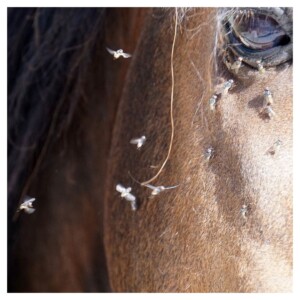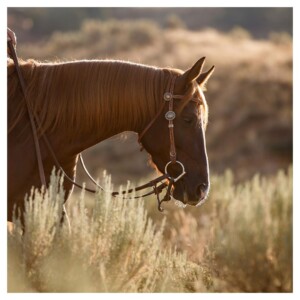Month: May 2023
Fly and Bug Protection for Horses
Summer is an excellent time for horse owners to enjoy the outdoors with their equine friends. However, summer also brings along an unwelcome guest – bugs! Insects like flies, mosquitoes, ticks, gnats, and biting midges can be a nuisance for both horses and their owners. In this blog post, we will explain the importance of bug protection for horses, overview the risks and discomfort caused by bugs, and discuss common bugs that affect horses in the summer. We will also provide you with some tips on how to manage bugs around the barn and how to choose the right bug protection for your horse.
Importance of Bug Protection for Horses
Bugs can cause a lot of discomfort for horses. They can cause horses to become restless, agitated, and anxious. Some horses may even develop skin irritation, rashes, and open sores due to bug bites. In addition, insects like mosquitoes and ticks can transmit serious diseases such as West Nile Virus, Lyme disease, and Equine Encephalitis. This is why bug protection is so important.
Common Bugs That Affect Horses in the Summer
Flies: Flies are the most common and annoying insects that horses have to deal with during the summer months. They can cause horses to become agitated and in some cases, even lead to fly-induced injuries.
Mosquitoes: Mosquitoes are known for their itchy bites and can transmit serious diseases to horses. Horses that live in areas with a high mosquito population are at risk of developing diseases like West Nile Virus and Equine Encephalitis.
Ticks: Ticks are a common problem in wooded areas and can transmit Lyme disease and other tick-borne diseases to horses. These diseases can cause severe health problems and can be challenging to treat.
Gnats: Gnats are tiny insects that can be difficult to spot but can cause a lot of discomfort to horses. They often bite horses on their faces and ears, which can cause skin irritation and itchiness.
Biting Midges: Biting midges, also known as no-see-ums, are tiny flies that can be difficult to see but can cause a lot of discomfort to horses. Their bites can cause severe itching and even lead to open sores.
Methods of Bug Protection
There are many methods of bug protection for horses, and each has its advantages and disadvantages. Here are some of the most common methods:
Fly Sheets and Masks: Fly sheets and masks are a popular method of bug protection. They provide a physical barrier between the horse’s skin and insects and can effectively keep flies and other biting insects away from the horse.
Fly-Repellent Sprays: Fly-repellent sprays are another popular method of bug protection. They can be sprayed directly onto the horse’s skin and provide several hours of protection against flies and other biting insects.
Fly Traps: Fly traps are a great way to reduce the fly population around the barn. They work by attracting flies to a sticky surface or a baited trap and can be very effective at reducing the number of flies in the area.
Stable Management Techniques: Good stable management practices like keeping the barn clean, removing manure promptly, and avoiding standing water can help reduce the number of insects around the barn.
Natural Remedies: Many natural remedies can be used to repel insects, such as vinegar, essential oils, and garlic. These remedies are often less toxic than chemical insecticides and can be a good option for horses with sensitive skin.
Choosing the Right Bug Protection for Your Horse
 When choosing bug protection for your horse, it’s essential to consider your horse’s individual needs and preferences. Some horses may be more sensitive to certain insecticides or may not like wearing fly masks or sheets.
When choosing bug protection for your horse, it’s essential to consider your horse’s individual needs and preferences. Some horses may be more sensitive to certain insecticides or may not like wearing fly masks or sheets.
It’s also important to take into account the severity of the bug problem in your area. If you live in an area with a high mosquito population, you may need to use a more potent insecticide or consider other methods like fly traps.
It’s also important to consider your horse’s daily activities and environment. If your horse spends a lot of time in the pasture, a fly sheet may be a better option than a fly mask. If your horse is sensitive to certain insecticides, you may need to experiment with different products until you find one that works well for your horse.
Tips for Managing Bugs Around the Barn
In addition to using bug protection for your horse, there are several things you can do to manage bugs around the barn:
Keep the barn and surrounding areas clean: Bugs are attracted to dirty, damp areas. Keeping the barn and surrounding areas clean and dry can help reduce the number of bugs in the area.
Remove manure promptly: Flies and other insects are attracted to manure, so it’s essential to remove it promptly from the barn and pasture.
Avoid standing water: Mosquitoes breed in standing water, so it’s crucial to eliminate any areas of standing water around the barn.
Use fans to keep horses cool and bugs away: Fans can help keep horses cool and also help keep flies and other insects away.
Use screens on windows and doors: Installing screens on windows and doors can help keep bugs out of the barn.
Plant insect-repelling plants: Several plants are known to repel insects, such as lavender, lemongrass, and citronella. Planting these around the barn and pasture can help reduce the number of bugs in the area.
Bug protection is integral to horse care, especially during the summer months. Flies, mosquitoes, ticks, gnats, and biting midges can cause a lot of discomfort for horses and even transmit serious diseases. There are many methods of bug protection, including fly sheets and masks, fly repellent sprays, fly traps, and natural remedies.
When choosing bug protection for your horse, it’s essential to consider your horse’s needs and preferences, the severity of the bug problem in your area, and your horse’s daily activities and environment. In addition to using bug protection, there are several things you can do to manage bugs around the barn, such as keeping the barn clean, removing manure promptly, and using fans and screens to keep bugs away. By taking these steps, you can help keep your horse comfortable and healthy during the summer months.
 The American Quarter Horse is a breed that has become an integral part of American history. It is a versatile horse breed known for its speed, strength, and agility. The breed’s origin can be traced back to colonial America when Spanish explorers brought horses to the new world. The horses were a cross between the Spanish Barb and the native horses of the American continent.
The American Quarter Horse is a breed that has become an integral part of American history. It is a versatile horse breed known for its speed, strength, and agility. The breed’s origin can be traced back to colonial America when Spanish explorers brought horses to the new world. The horses were a cross between the Spanish Barb and the native horses of the American continent.